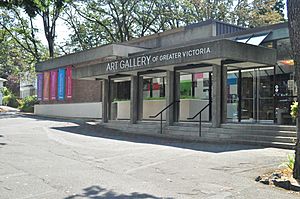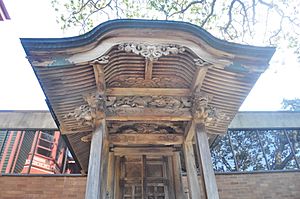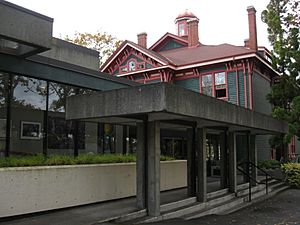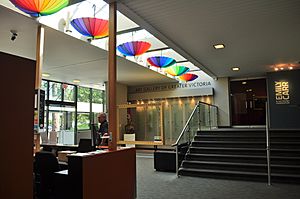Art Gallery of Greater Victoria facts for kids

Main entrance to the art gallery
|
|
| Established | 1946 |
|---|---|
| Location | 1040 Moss Street, Victoria, British Columbia, V8V 4P1 |
| Type | Art museum |
| Visitors | 54,998 (2015–16) |
The Art Gallery of Greater Victoria (AGGV) is a cool art museum in Victoria, British Columbia, Canada. It's located in a neighborhood called Rockland. The museum is made up of two main parts: the old Spencer Mansion and the newer Exhibition Galleries.
The Spencer Mansion was built way back in 1889. The Exhibition Galleries were added later, in the middle of the 1900s. Together, these buildings cover a large area, about 2,474 square meters (26,635 square feet).
The museum started in 1946 as the Little Centre in downtown Victoria. In 1951, it moved to the Spencer Mansion. That's when it got its current name, the Art Gallery of Greater Victoria. Over the years, the museum added more space to show off its art.
The AGGV has a huge collection of art. You can see works by Canadian artists, Indigenous Canadian artists, and artists from countries around the Pacific Rim. It has the largest art collection of any museum in British Columbia, with about 20,000 pieces!
Contents
History of the Art Gallery
The Art Gallery of Greater Victoria was started in 1946. It was created by artists and people who loved art from the Vancouver Island area. They first called it the Little Centre. For five years, from 1946 to 1951, it was located in an old car dealership in downtown Victoria.
In 1951, something exciting happened! A woman named Sarah Spencer donated her large home, the Spencer Mansion, to the museum. The museum then moved into this beautiful building. When it reopened at the Spencer Mansion, it was renamed the Art Gallery of Greater Victoria. Even after it became a museum, caretakers for the building lived there until the 1960s.
After moving, the museum quickly started to grow. They built new parts called the Exhibition Galleries. These new galleries were added in different stages. The first new gallery opened in 1958, and the last one was finished in 1978. This helped the museum show more of its growing art collection.
In 2012, the museum announced plans to make the Exhibition Galleries even bigger. The city government approved these plans in 2015. The expansion would add more space for art, plus a new cafe and a lecture hall. Construction was planned to start in late 2019. However, the cost of building materials went up, so the project was put on hold. The museum plans to close its building during construction and show its art in other places around Victoria.
Exploring the Museum's Architecture
The Art Gallery of Greater Victoria is made up of two main parts. One part is the Spencer Mansion, which is an old house from 1889. The other part is the Exhibition Galleries, which are seven modern art spaces built between the 1950s and 1978. Together, these buildings cover about 2,474 square meters (26,635 square feet).
The Spencer Mansion
The Spencer Mansion was built in 1889. It was designed by William Ridgeway Wilson. This grand house was once part of a much larger property. It had a big garden, tennis courts, stables, and a coach house. The mansion even had a special tower called a belvedere where you could see the ocean!
The house was first built for the Green family. They named it Gyppeswyk, which is an old English name for Ipswich. For a short time in 1903, it was even used as the home for the Lieutenant Governor of British Columbia after their original house burned down. In 1951, Sarah Spencer gave the mansion to the art institution.
The outside of the mansion has been painted many different colors over the years. In 1975, it was painted cream to match the brick of one of the new galleries. But in 2004, workers peeled back 15 layers of paint to find its original colors. Now, it's painted dark red, dark green, and pale salmon, just like it was when it was new!
Some parts of the mansion's outside were changed when the new galleries were built in the 1950s. For example, a covered entrance for carriages was removed. Also, a glass staircase was added on the north side. Even with these changes, the mansion still has many original features inside. You can still see its first fireplace, fancy tiles, and beautiful wooden details on the second floor. In 2004, the roof's special window was rebuilt, and the chimney was made stronger to protect it from earthquakes.
Today, the first floor of the Spencer Mansion has the museum's gift shop. It also has an office where you can rent or buy art. The old bedrooms on the second floor are now the museum's offices and library. The museum's old records are kept in the attic.
The Exhibition Galleries
From 1955 to 1978, the museum added seven new galleries next to the Spencer Mansion. These are called the Exhibition Galleries. They have a modern design. The first two galleries opened in 1958 and 1959. They were called the Centennial Galleries to celebrate 100 years since the Colony of British Columbia was formed. The last big updates to these galleries happened in 1978.
More updates to the Exhibition Galleries happened from 2001 to 2003. During this time, a new climate control system was put in. This system helps keep the air at the right temperature and humidity. This is very important because it allows the museum to host special art shows that need a controlled environment to protect the artworks. The museum's entrance and hallways in the Exhibition Galleries were also updated during these renovations.
The Museum's Permanent Collection
As of September 2019, the Art Gallery of Greater Victoria has about 20,000 pieces of art in its permanent collection. This makes it the largest art collection of any museum in British Columbia! However, because the museum building has limited space, only about five percent of this huge collection can be shown at one time.
The collection is divided into different types of art. These include Asian art, Canadian art, contemporary (modern) art, decorative art, and Indigenous Canadian art.
Asian Art Collection
The museum's collection of Asian art is very impressive. It has about 8,000 works, which is 40 percent of the museum's entire collection! This makes it the second largest collection of Asian art in Canada, after the Royal Ontario Museum. While the collection includes art from all over Asia, it mostly focuses on works from China and Japan.
The Asian art collection has both old and new pieces. You can see bronze objects, ceramics, textiles, and carvings made from amber and ivory. The museum started collecting Asian art in 1973. The first two items were Japanese prints bought in the 1950s.

Other amazing works in this collection include a Chinese painting. There's also a Japanese screen called a byōbu made by Kanō Sanraku. This screen shows a peacock with its beautiful feathers next to a pine tree, painted on gold leaf. The screen is very large, about 197 cm (77.6 inches) tall and 370 cm (145.7 inches) wide. It was given to the museum in 1995 and was carefully restored with help from the Government of Japan.
Outside the museum, there's an Asian garden. In this garden, you can find the only Meiji era Shinto shrine in North America. It's a special place to visit!
See also
- List of art museums
- List of museums in British Columbia




